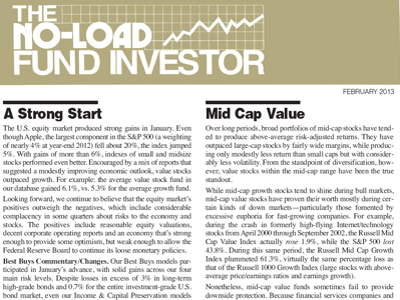
The investment world is filled with data, information and opinions. The problem for investors is knowing what information is worth listening to and what information is best ignored. Perhaps the best thing that ever happened to me was mentoring under my father, George Marotta, who I consider to be a financial Rembrandt. He helped me develop methods to filter what is worth considering, and the adaptive techniques to judge its worthiness looking forward.
One monthly publication which he introduced me to and that I am still reading is Mark Salzinger’s The No-Load Fund Investor. The publication has model portfolios and data on many of the leading no-load funds and ETFs. But the portion I enjoy the most is his commentary. The latest February, 2013 issue had an article entitled “Mid Cap Value” which began with:
Over long periods, broad portfolios of mid-cap stocks have tended to produce above-average risk-adjusted returns. They have outpaced large-cap stocks by fairly wide margins, while producing only modestly less return than small caps but with considerably less volatility. From the standpoint of diversification, however, value stocks within the mid-cap range have been the true standout.
While mid-cap growth stocks tend to shine during bull markets, mid-cap value stocks have proven their worth mostly during certain kinds of down markets—particularly those fomented by excessive euphoria for fast-growing companies. For example, during the crash in formerly high-flying Internet/technology stocks from April 2000 through September 2002, the Russell Mid Cap Value Index actually rose 1.9%, while the S&P 500 lost 43.8%. During this same period, the Russell Mid Cap Growth Index plummeted 61.3%, virtually the same percentage loss as that of the Russell 1000 Growth Index (large stocks with above average price/earnings ratios and earnings growth).
Salzinger went on to warn against when and why mid-cap value funds sometimes fail to provide downside protection, but the primary point of the article was in complete agreement with our own analysis of portfolio construction. Mid-cap value should be part of any U.S. stock allocation which wants to remain invested in the markets, but is worried about potential corrections.
For more information on how mid-cap value out performs on a risk adjusted basis, we wrote an extensive analysis in an article last year, “Style Boxes and the Efficient Frontier.” Finally for subscribers we have an extensive video which goes through the analysis in even more detail:
Subscribe to Marotta On Money and receive free access to a video seminar on: Boosting Returns through Static and Dynamic Asset Allocation.